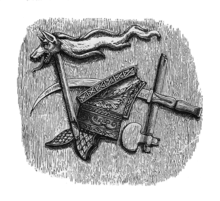Proposed marriage
According to Appian, Antony is responsible for the statement that Augustus sought to secure the goodwill of Cotiso, king of the Getae (Dacians) by giving him his daughter, and he himself marrying a daughter of Cotiso. [3] According to Suetonius, Cotiso refused the alliance and joined the party of Antony. [4] Suetonius (LXIII, Life of Augustus) says Mark Antony wrote that Augustus betrothed his daughter Julia to marry Cotiso (M. Antonius scribit primum eum Antonio filio suo despondisse Iuliam, dein Cotisoni Getarum regi) to create an alliance between the two men. This failed when Cotiso betrayed Augustus. Julia ended up marrying her cousin Marcus Claudius Marcellus.
According to Dio, the story about the proposed marriages is hardly credible and may have been invented by Mark Antony as propaganda to offset his own alliance with Cleopatra. [4]
This article covers the history and bibliography of Romania and links to specialized articles.

Dacia was the land inhabited by the Dacians, its core in Transylvania, stretching to the Danube in the south, the Black Sea in the east, and the Tisza in the west. The Carpathian Mountains were located in the middle of Dacia. It thus roughly corresponds to the present-day countries of Romania, as well as parts of Moldova, Bulgaria, Serbia, Hungary, Slovakia, and Ukraine.
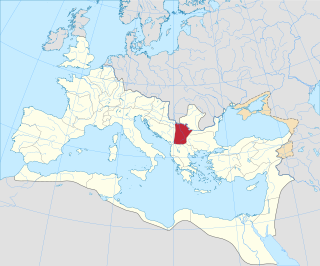
Moesia was an ancient region and later Roman province situated in the Balkans south of the Danube River, which included most of the territory of modern eastern Serbia, Kosovo, north-eastern Albania, northern parts of North Macedonia, Northern Bulgaria, Romanian Dobruja and small parts of Southern Ukraine.

The Dacians were the ancient Indo-European inhabitants of the cultural region of Dacia, located in the area near the Carpathian Mountains and west of the Black Sea. They are often considered a subgroup of the Thracians. This area includes mainly the present-day countries of Romania and Moldova, as well as parts of Ukraine, Eastern Serbia, Northern Bulgaria, Slovakia, Hungary and Southern Poland. The Dacians and the related Getae spoke the Dacian language, which has a debated relationship with the neighbouring Thracian language and may be a subgroup of it. Dacians were somewhat culturally influenced by the neighbouring Scythians and by the Celtic invaders of the 4th century BC.
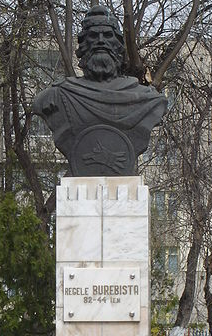
Burebista was the king of the Getae and Dacian tribes from 82/61 BC to 45/44 BC. He was the first king who successfully unified the tribes of the Dacian kingdom, which comprised the area located between the Danube, Tisza, and Dniester rivers, and modern day Romania and Moldova. In the 7th and 6th centuries BC it became home to the Thracian peoples, including the Getae and the Dacians. From the 4th century to the middle of the 2nd century BC the Dacian peoples were influenced by La Tène Celts who brought new technologies with them into Dacia. Sometime in the 2nd century BC the Dacians expelled the Celts from their lands. Dacians often warred with neighbouring tribes, but the relative isolation of the Dacian peoples in the Carpathian Mountains allowed them to survive and even to thrive. By the 1st century BC the Dacians had become the dominant power.

The Kosons are the only gold coins that have been minted by the Dacians, named after the Greek alphabet inscription "ΚΟΣΩΝ" on them. It is thought that "Koson" is the name of an otherwise historically unrecorded Dacian king, though he may be identical to the Cotison mentioned by Horace and Suetonius.
The Dacian Wars were two military campaigns fought between the Roman Empire and Dacia during Emperor Trajan's rule. The conflicts were triggered by the constant Dacian threat on the Danubian province of Moesia and also by the increasing need for resources of the economy of the Empire.

The Anartes were Celtic tribes, or, in the case of those sub-groups of Anartes which penetrated the ancient region of Dacia, Celts culturally assimilated by the Dacians.
Rholes or Roles was a Getae chieftain in Scythia Minor mentioned by Cassius Dio in his Roman History. According to Dio, he helped Roman general Marcus Licinius Crassus defeat the Bastarnae, and when he visited Octavian, he was treated as "a friend and ally" for his support for the Romans. Later he sent for Crassus to help in his conflict with Getae chieftain Dapyx. These events have been dated to 31-27 BC.
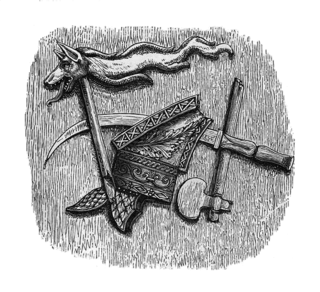
Comosicus was a Dacian king and high priest who lived in the 1st century BC. The only reference to Comosicus is a passage in the writings of the Roman historian Jordanes.

Duras, also known as Duras-Diurpaneus, was king of the Dacians between the years AD 69 and 87, during the time that Domitian ruled the Roman Empire. He was one of a series of rulers following the Great King Burebista. Duras' immediate successor was Decebalus.
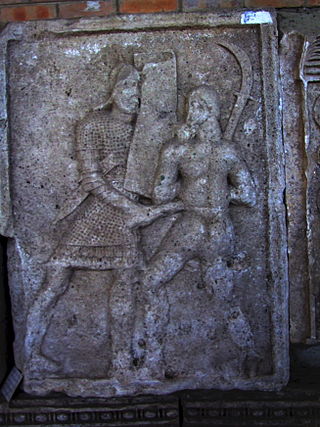
The history of Dacian warfare spans from c. 10th century BC up to the 2nd century AD in the region defined by Ancient Greek and Latin historians as Dacia, populated by a collection of Thracian, Ionian, and Dorian tribes. It concerns the armed conflicts of the Dacian tribes and their kingdoms in the Balkans. Apart from conflicts between Dacians and neighboring nations and tribes, numerous wars were recorded among Dacians too.
Krobyzoi is a Thracian, Getic or Dacian tribe.
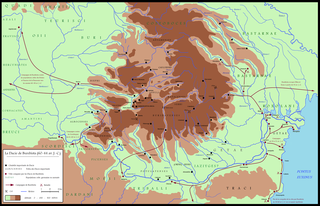
Teurisci was a Dacian tribe at the time of Ptolemy. They were originally considered a branch of the Celtic Taurisci (Noricum), who moved to Upper Tisza. However, the archaeology shows that Celts have been absorbed by Dacians, at some point creating a Celto-Dacian cultural horizon in the upper Tisza.
Gaius Cassius Parmensis was a Roman politician and a Latin writer of the late Roman Republic, who belonged to the circle of conspirators against Gaius Julius Caesar.
The Antiquity in Romania spans the period between the foundation of Greek colonies in present-day Dobruja and the withdrawal of the Romans from "Dacia Trajana" province. The earliest records of the history of the regions which now form Romania were made after the establishment of three Greek towns—Histria, Tomis, and Callatis—on the Black Sea coast in the 7th and 6th centuries BC. They developed into important centers of commerce and had a close relationship with the natives. The latter were first described by Herodotus, who made mention of the Getae of the Lower Danube region, the Agathyrsi of Transylvania and the Sygannae of Crişana.
Slavery in Dacia was widespread both among the Dacian and Getae tribes and after the Roman conquest of Dacia.
